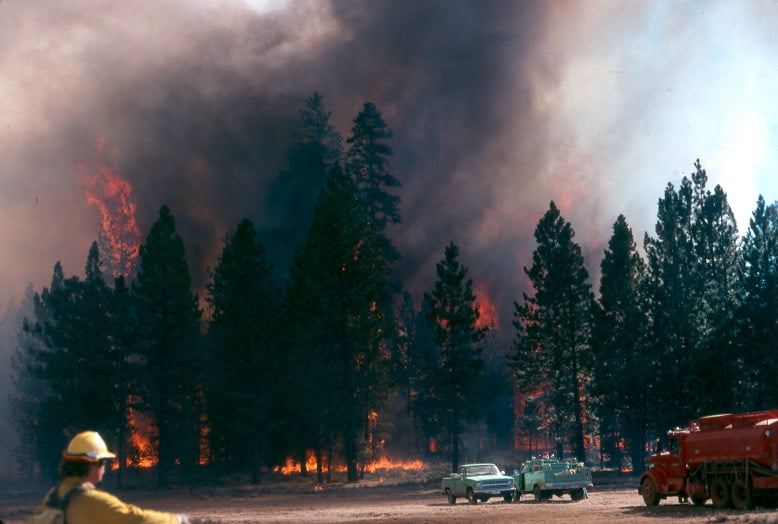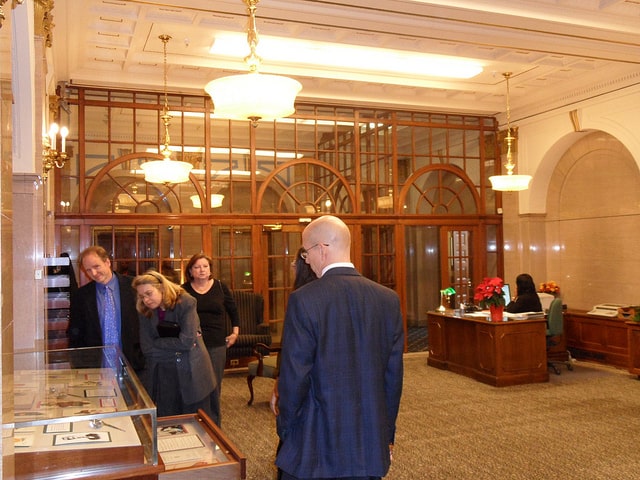
To open the discussion, I asked Jim Furnish, former Deputy Chief of the National Forest System, to share the good and the bad of his experiences with politicals. For those of you who are not Forest Service folks, the chain of command goes like this: the Secretary of Agriculture (now Sonny Perdue) is over the Undersecretary over the Forest Service (now Jim Hubbard, formerly State Forester of Colorado). Those are political folks, and under that is the Chief of the Forest Service (not technically political, that’s a historic discussion in and of itself, but new Administrations of a different color tend to get rid of the old ones, in more or less dramatic ways), and the Deputy Chief for the National Forest System is the next layer down. There are other Deputy Chiefs, e.g. State and Private, that are over state and private programs and Fire, and Research and Development, Administration and International Programs, but the main issues that concern us here (other than fire) are all within the purview of the Deputy Chief for NFS. For example, the Director of Ecosystem Management Coordination (EMC) where litigation, NEPA and Planning are housed, works for that person in DC. One of the ways it’s confusing is that the Regional Foresters actually work for the Chief, but when Jim Furnish was Deputy Chief they worked for him. (See it’s even confusing to former employees). It’s fairly complicated-both the way it sounds and the way it works, with lots of opportunities for tension between the line and staff folks at various levels. Oh and let’s not forget that the Washington Office, at least before efforts for “work at home”, was a six-story rumor mill with tendrils of information, of unknown quality, like the game “Telephone” dissipating throughout the country.
For non-FS people this may be all too much bureaucracy, but it can help to understand the ways that authority can be both straightforward (line to line) and diffused (all those staff people at different levels).
I think Jim’s stories are all worthy of consideration, so this will be a series. Others are welcome to submit their own advice or stories, either as a separate post (email me) or in the comments below. As usual, let’s reflect on irritating or helpful behaviors on the part of politicals, not so much saying bad things about individual human beings. Also, I’d ask you to note how important trust is..the interface is people suddenly working together who feel that there are high stakes, and don’t have experience working together, nor, many times, any basic level of trust. I like the way Jim does the Good and the Bad, so these posts will be longer than usual. Now onto Jim’s post.
It Was the Best of Times; It Was the Worst of Times . . .
The interface which resource agencies and their leaders navigate between “doing right by the land” and doing the bidding of politicos is fraught with intrigue. As Deputy Chief of the Forest Service (1999-2002), I had a front row seat as observer and occasional participant during the latter part of the Clinton administration and early Bush one. The politicization of the agency has ramped up in an ever more partisan manner, especially since the spotted owl crisis. With Congress in gridlock, the executive branch has become the primary driver of policy formulation. I thought it might be instructive to share a couple “inside stories” that illustrate both the best and worst of agency politics. Each involves the Undersecretary for Agriculture — a political appointee overseeing the Forest Service and its Chief – a person I had frequent direct contact with while dealing with national forest issues.
Dave Tenney came to USDA in 2001 from a lead staff position with the House Natural Resources Committee. He remained in an “acting” capacity for many months while Mark Rey awaited Senate confirmation.
The Bad: When Ann Veneman of CA became Secretary of Agriculture, it seemed every party there with a bone to pick with the FS pestered her office for a fix. Early in 2001, Dave Tenney asked to see me about a matter involving TV towers atop Mt. Wilson in Angeles NF. Univision claimed that a tower that Disney had started to build would interfere with its transmission. Tenney noted these were “powerful, influential” parties and he directed me to “fix it” as he dropped an issue folder in front of me. I quickly examined the contents, and then explained that lawyers were already involved, the issue had a technical component that would require FCC involvement, and it would also be necessary to confer with the Region and Forest to inquire about background and what had already transpired. Then we could get the parties together with FCC and see about brokering a deal. “How long will that take?” I estimated about a week. He said he needed this done “tomorrow”. I noted this was unrealistic; simply impossible. He pressed on saying it was essential to get this fixed now (reflecting Veneman’s demand, I suspect). I quietly stared at him contemplating my next move. I told Tenney I understood the gravity and the urgency, but a substantive, reasonable solution needed a lot of work and coordination, many meetings, and a need to calm the lawyers while we found a solution that fit the facts. Tenney glared and demanded faster action. I then said “If you want me to take care of this I will – I need a week. If you want it done faster, then you do it.” Then I returned the folder. He reluctantly told me to deal with it and brief him when solved, which I did a week later. This was about March 2001, and I left the FS in January 2002. What little trust and optimism existed for a Clinton-era deputy chief to work effectively with a Bush appointee evaporated. Tenney and I almost never spoke again.
The Good: The tragic Thirtymile Fire (July 2001) in WA burned over a fire crew and 2 civilians, killing 4 firefighters and nearly all 16 hunkered in fire shelters. I received a midnight call asking if I would lead the fatality investigation. I agreed to do so. Chief Dombeck, shortly before he retired in April, had ripped into all his leadership group saying that the last time a fatality occurred, the safety officer had fielded 17 declinations until someone said ”Yes” to lead an investigation. In the future, Dombeck said “if your name is on top of the list when called, you WILL serve!” My name was on top for July 1-15. I departed for WA the next morning after briefing Chief Bosworth, who had just succeeded Dombeck.
The investigation team, including OSHA reps, proceeded briskly to determine the basics of what happened. Intensive Regional TV coverage covered every development and clamored for answers.
After 1 week we readied for a major press conference to lay out our findings. A lengthy report would follow after further investigation, but we had established a basic fact pattern that could dispel many myths. Then Chief Bosworth called to say he was sending his communications director to “manage the event”. This did not sit well with me. Our local public affairs officer and investigation team had performed well and we were ready as could be. My interactions with the natl comm dir led me to conclude he screwed up everything he touched and this event was too important. Further, I sensed the Chief had little or no confidence in me. I told the Chief he need not send him. Bosworth said it had “already been decided” (though I do not know if Tenney was involved, I suspected so). So I said he needed to understand that if he came to WA I would resign my position as investigation team leader immediately. I knew that the Chief could not stand the scandal of my departure one week in. There was a long pause on the phone.
Bosworth said “I’ll see what I can do”. The comm dir stayed home, and we had a good press conference that effectively addressed the media’s questions and allowed us to proceed with the balance of our work. In this case, I think my taking a stand had a good outcome and fostered improved respect and trust — with Bosworth, at least, who listened and understood and agreed to a mutually satisfactory outcome.


